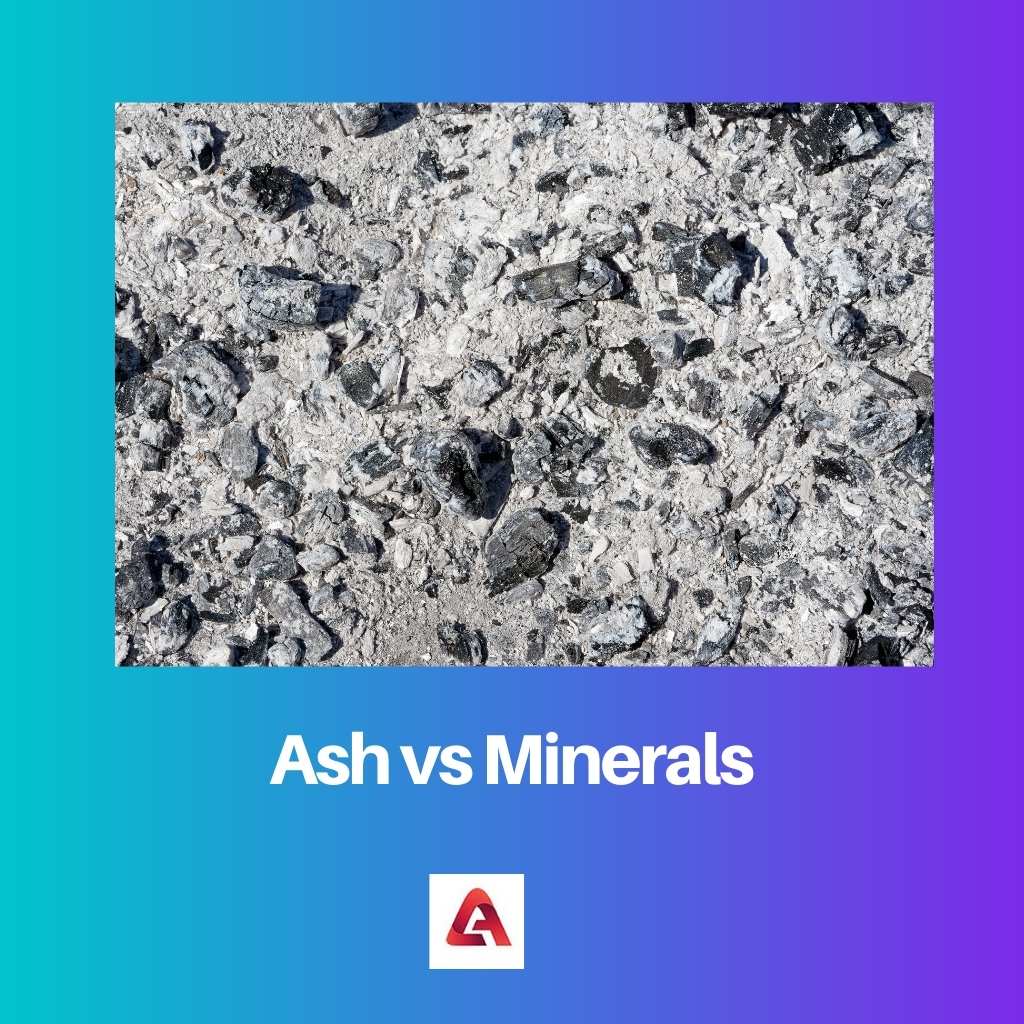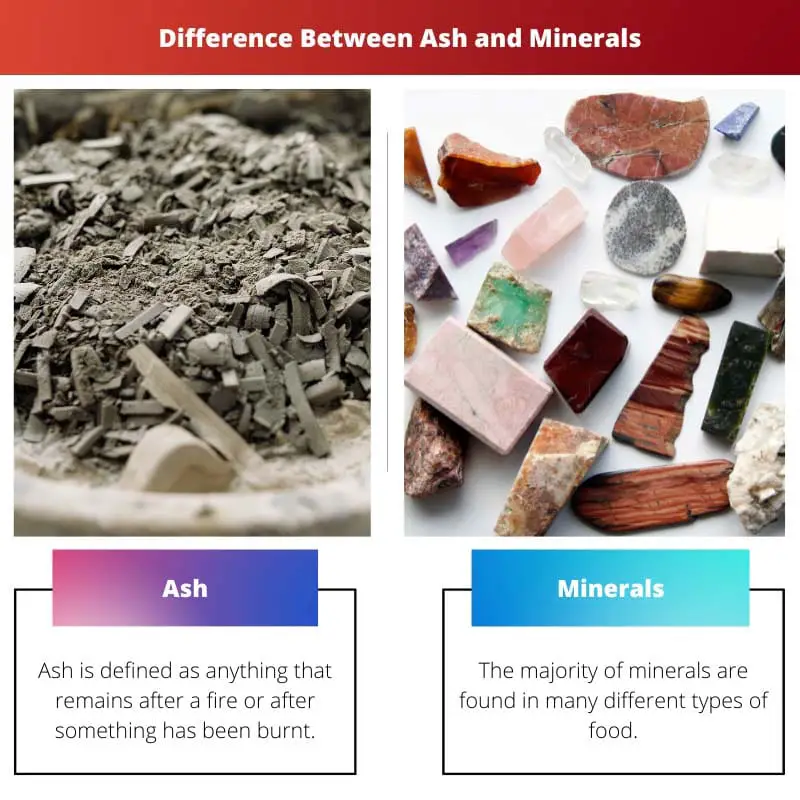The difference between Ash and Minerals is that ash is a pure form of carbon, while minerals are compounds. The purpose of ash is to increase the pH of the soil, which can improve crop yield.
However, too much ash may have adverse effects on the crops. Minerals are non-carbon-based compounds essential for plant growth and development (e.g., potassium and nitrogen).
Ash also improves soil fertility by increasing its pH value, while minerals help plants grow by providing nutrients such as potassium nitrate (KNO3), magnesium oxide (MgO), calcium oxide (CaO), etc.
Key Takeaways
- Ash is the inorganic matter left over after combustion, while minerals are naturally occurring substances in the earth’s crust.
- Ash contains a higher concentration of heavy metals than minerals, making it more harmful to the environment and human health.
- The composition of ash varies depending on the source material, whereas minerals have a specific chemical structure.
Ash vs Minerals
The difference between Ash and Minerals is that ash is a waste product of burning organic material like wood or coal. On the other hand, Minerals are inorganic compounds that occur naturally in the environment. Ash are normally alkaline in nature, whereas minerals are acidic in nature.

Ash is defined as anything that remains after a fire or after something has been burnt. Ash is a byproduct of the combustion processes, and it consists of fine, non-combustible particles of mineral matter.
Ashes may gradually scatter in soil and making it productive. Ashes stay intact under soil for an extended period, even long enough to develop into coal.
The majority of minerals are found in many different types of food. However, some foods contain higher amounts of particular minerals than others.
Some foods also contain exceptionally high amounts of a single mineral but only in small amounts because they can be harmful if eaten too or in large quantities.
Comparison Table
| Parameters of Comparison | Ash | Minerals |
|---|---|---|
| Chemical nature | Ash is alkaline. | Minerals are acidic. |
| Physical properties | Ash is made up of small and powdery particles. | Minerals are naturally hard. |
| Amorphous nature | Ash is amorphous. | Minerals are not amorphous. |
| Colors | The color of ash is determined by the amount of unburned carbon and iron present, ranging from orange to deep red, white, or yellow. | Minerals come in various colors, including red, blue, green, pink, purple, and orange. |
| Uses | Ash is used for food preservation, pest control, and gardening. | Minerals are used for pipes, bricks, and the manufacture of concrete. |
| well-known type | One of the most well-known types of ash is wood ash. | One of the most well-known is diamond. |
What is Ash?
The burning process results in creating smoke, heat, light, and ash. All non-aqueous, non-gaseous leftovers that remain after something burns are called ash. Ashes are available in different forms such as:
Fly ash: Fly ash comes from coal-burning. It is an excellent powdery material, and it constitutes around 15% of the combustion products.
Coal fly ash contains metals like aluminum and iron oxides, calcium oxide, and phosphorus oxide. Fly ash can be used as a building material in concrete blocks, bricks, or as mortar mixes with cement.
Bottom ash: Bottom ash is formed during burning waste or coal in fireplaces or furnaces. This type of ash is coarser than fly ashes but still looks like black sand or gravel.
Bottom ashes are primarily used in road construction because they can be substituted for gravel or sand to produce asphalt concrete.
Wood Ash: Wood ashes are produced chiefly from wood-burning stoves and fireplaces. The ash produced from wood-burning contains many nutrients like potassium carbonate (potash) and lime.
Ashes are the remains of something that has been burned. Once a fire dies down and the ashes are left, they are not entirely useless.
Although they are useless for the specific purpose of keeping a fire going, they have many other characteristics that make them valuable to us.
Ashes are used as a cleaning agent. You can also mix them with water and use them as soap to clean your hands or clothes.
It can also be mixed with water and used to clean glass and mirrors in your home. You can even use ashes to get rid of stubborn stains on clothes or carpets.

What is Minerals?
Minerals are necessary for your body’s wellbeing. Minerals are used by your body for a variety of functions, including keeping your bones, muscles, heart, and brain in good functioning order.
Minerals are also required for the production of enzymes and hormones. Minerals are divided into two categories: macrominerals and trace minerals.
Macrominerals are required in greater quantities than trace minerals. Sodium, potassium, chloride, calcium, phosphorus, magnesium, and sulphur are all macrominerals.
Minerals are inorganic compounds, which means they are not made of carbon. Some minerals have a specific chemical formula, such as calcium carbonate (CaCO3), but others have a complex or variable composition.
For example, the mineral pyrite has a variable composition and can be composed of several different elements, including iron (Fe), sulfur (S), and oxygen.
Minerals are naturally occurring substances that are solid and have an ordered atomic structure. They do not come from living things.
Animals and plants take minerals from their diet, so many foods contain minerals.
However, the minerals in food do not come from living things — they come from the soil or water where the plants grew or from the water where the animals lived.

Main Differences Between Ash and Minerals
- Ash is amorphous, although Minerals are not amorphous.
- The nature of ash is that it is alkaline. Minerals, on the other hand, are acidic by nature.
- The proportion of unburned carbon and iron in ash determines its color, ranging from orange to deep red, white, or yellow, whereas minerals come in various colors such as red, blue, green, pink, purple, and orange.
- Ash is used for food preservation, insect control, and gardening, while Minerals make pipes, bricks, and concrete.
- Wood ash is one of the most well-known varieties of ash, but diamond ash is one of the most well-known.
- Ash is made up of microscopic, powdery particles, whereas Minerals are inherently complex.

- https://www.researchgate.net/profile/Jan-Wastiels/publication/279908335_Mineral_polymer_based_on_fly_ash/links/55a67b7008aeb4e8e6469244/Mineral-polymer-based-on-fly-ash.pdf
- https://link.springer.com/chapter/10.1007/978-1-4615-6998-5_35
